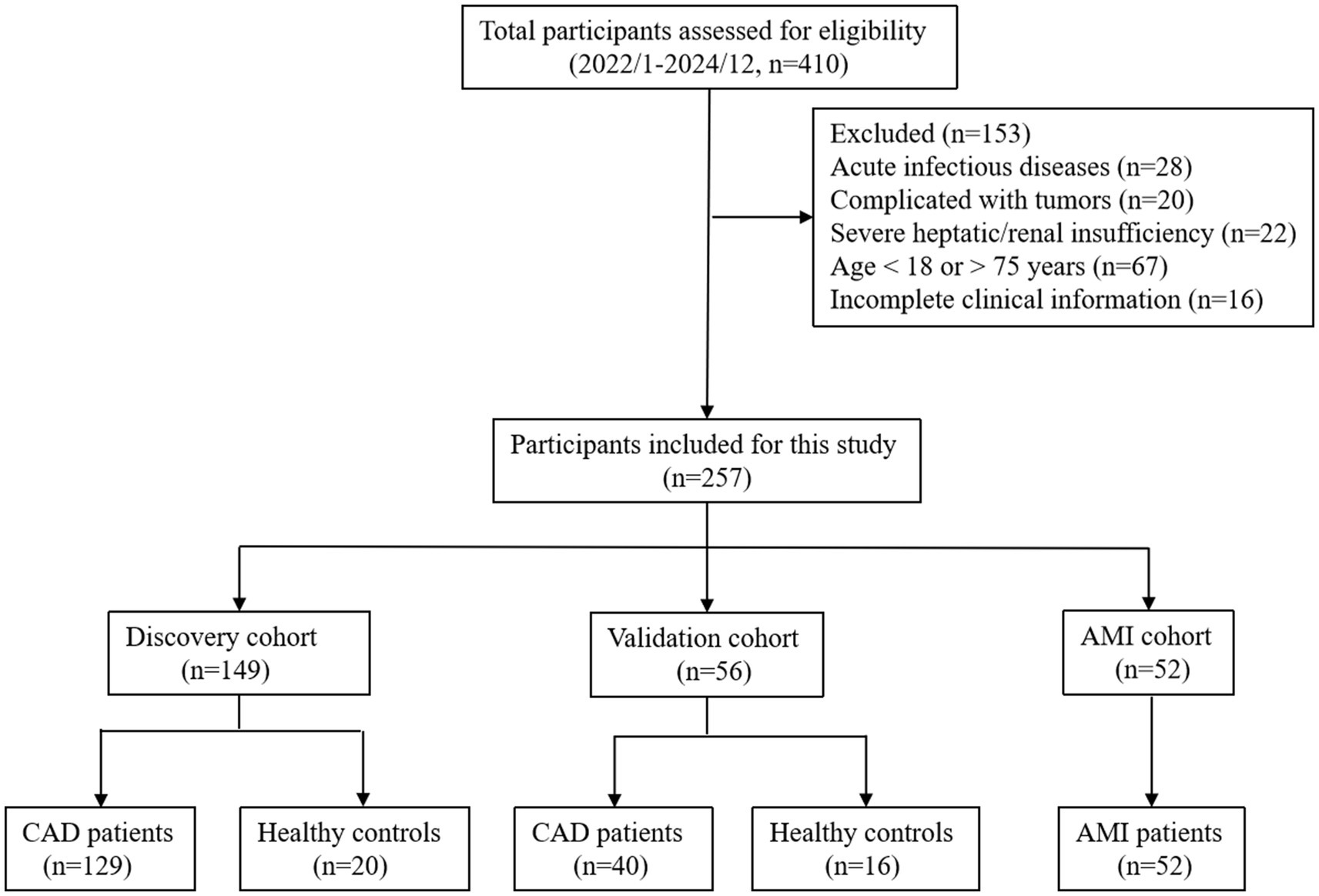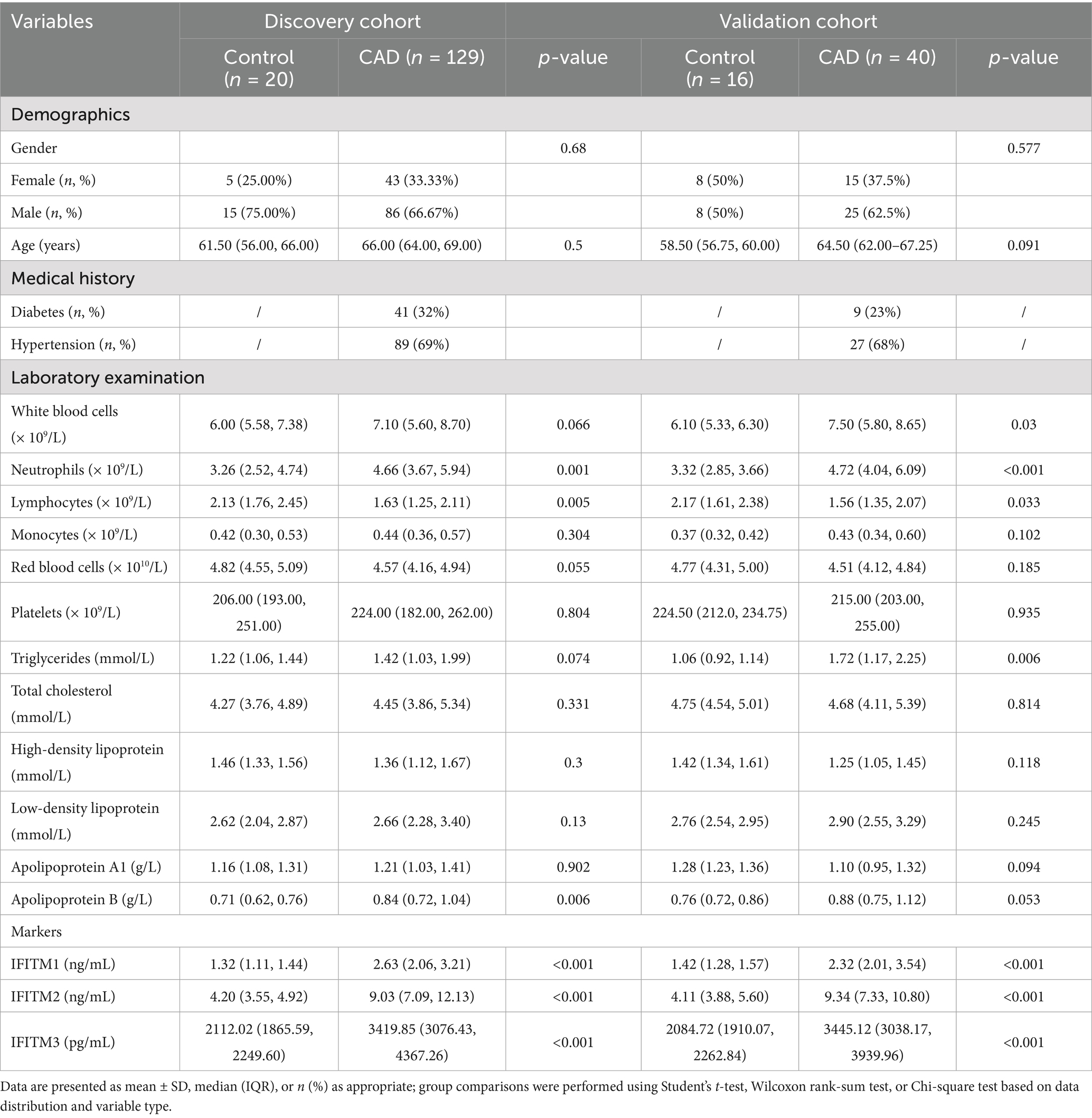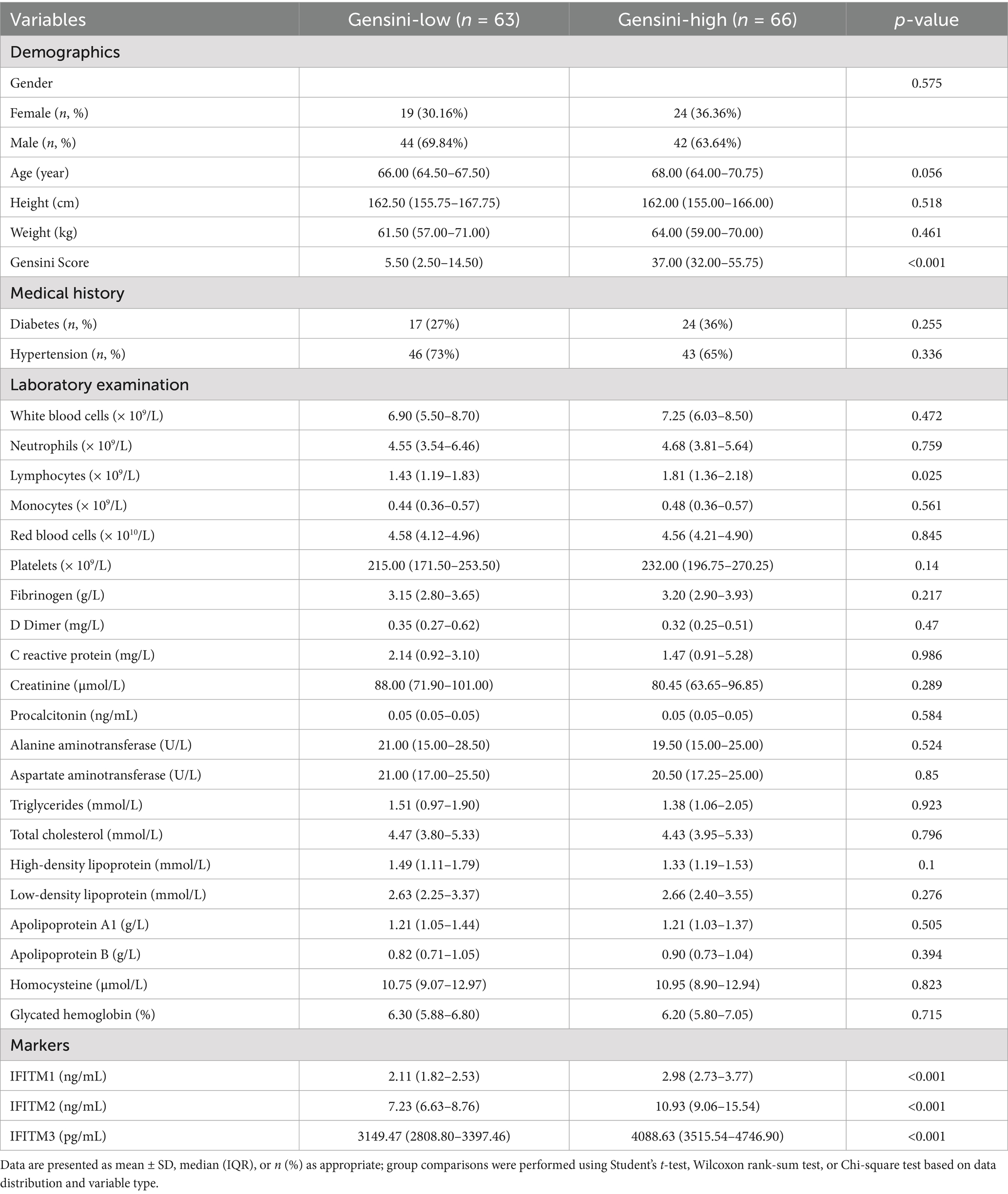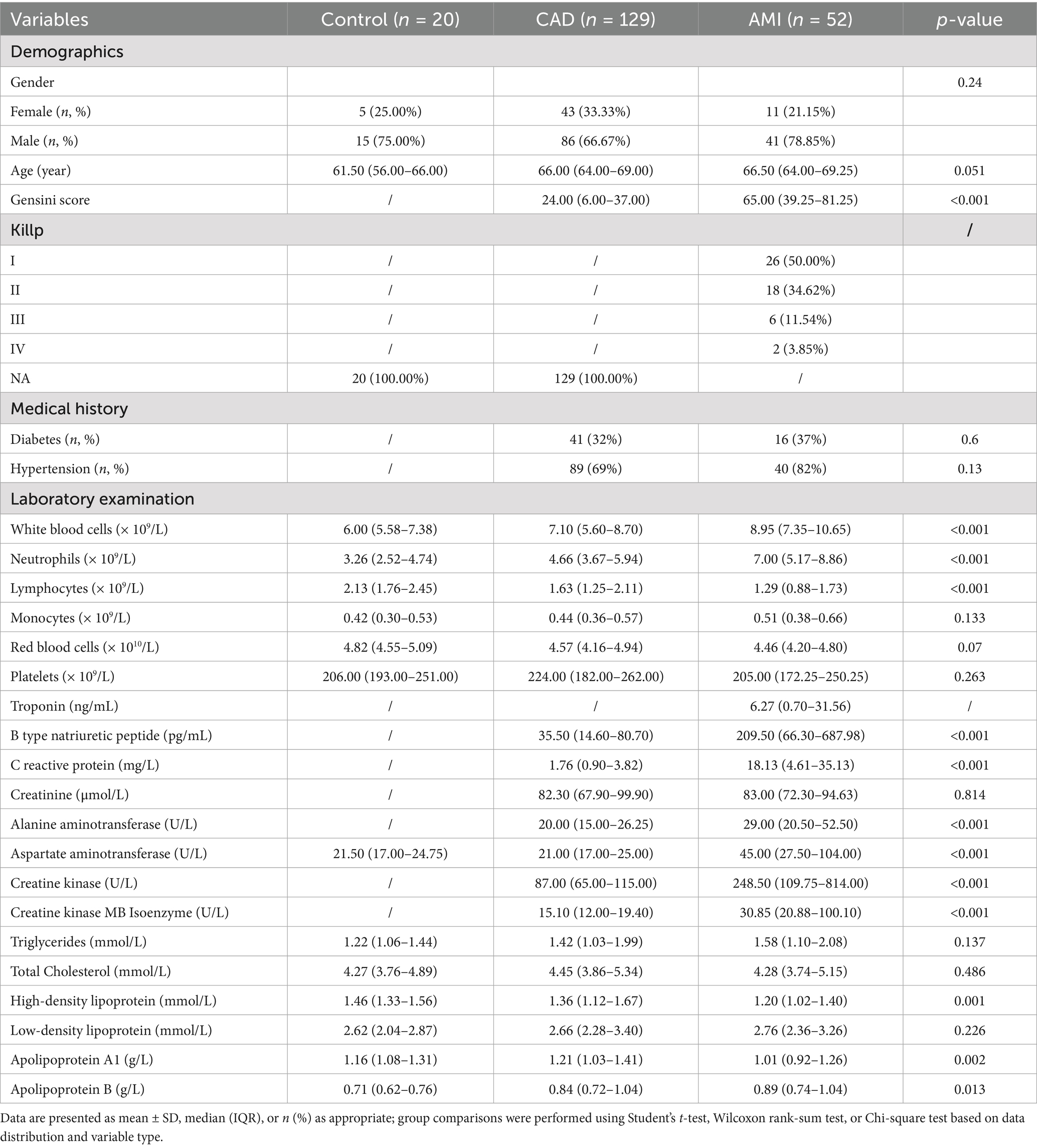- 1Institute of Cardiovascular Disease, Affiliated Meizhou Hospital of Shantou University Medical College, Meizhou, China
- 2Guangdong Provincial Engineering and Technological Research Center of Clinical Molecular Diagnosis and Antibody Drugs, Meizhou People’s Hospital (Huangtang Hospital), Meizhou Academy of Medical Sciences, Meizhou, China
- 3Department of Clinical Pharmacy, Meizhou People’s Hospital (Huangtang Hospital), Meizhou Academy of Medical Sciences, Meizhou, China
- 4GuangDong Engineering Technological Research Center of Molecular Diagnosis in Cardiovascular Diseases, Meizhou People’s Hospital (Huangtang Hospital), Meizhou Academy of Medical Sciences, Meizhou, China
- 5Center for Cardiovascular Diseases, Meizhou People's Hospital (Huangtang Hospital), Meizhou Academy of Medical Sciences, Meizhou, China
Backgroud: Biomarker discovery remains pivotal for improving coronary artery disease (CAD) and acute myocardial infraction (AMI) diagnosis. While interferon-induced transmembrane proteins (IFITM1/2/3) are established in viral defense and cancer progression, their roles in cardiovascular pathologies are undefined.
Methods: A retrospective cohort study was conducted, including a discovery cohort (129 CAD patients and 20 controls), a validation cohort (40 CAD patients and 16 controls) and a third cohort of 52 patients with acute myocardial infraction (AMI). Serum IFITM1/2/3 levels were specifically quantified using enzyme linked immunosorbent assay (ELISA). Coronary stenosis severity was assessed using the Gensini score. The evaluation of diagnostic performance utilized receiver operating characteristic (ROC) curves, whereas Spearman’s rank test facilitated the analysis of correlations.
Results: Compared with controls, CAD patients exhibited significantly elevated serum IFITM1/2/3 levels (p < 0.001). ROC analysis demonstrated exceptional diagnostic accuracy for CAD detection: IFITM1 (AUC 0.9375, sensitivity 95%, specificity 81.25%), IFITM2 (AUC 0.8984, sensitivity 90%, specificity 75%), and IFITM3 (AUC 1.000, sensitivity 97.5%, specificity 100%). IFITM levels were significantly positively correlated with Gensini scores (p < 0.0001), indicating a plaque burden-dependent expression pattern. AMI patients exhibited further elevation of IFITM1/2/3 compared to patients with stable CAD (p < 0.0001), with IFITM1 specifically upregulated in AMI with heart failure (3.07 vs. 4.64 ng/mL, p = 0.003).
Conclusion: IFITM1/2/3 may serve as novel serum biomarkers for diagnosing CAD and AMI, as well as stratifying coronary stenosis severity, with high discriminatory capacity. Our findings position IFITMs as promising tools for precision cardiovascular risk assessment and therapeutic targeting.
1 Introduction
Coronary artery disease, a leading cause of mortality worldwide, has been recognized as a global public health problem (1). The underlying pathology of CAD is defined by the formation of atherosclerotic plaques, which involve complex processes such as endothelial dysfunction, lipid accumulation, inflammatory reactions, and thrombosis (2, 3). The clinical spectrum of CAD includes symptoms from stable angina and unstable angina to catastrophic consequences such as myocardial infarction (MI), heart failure (HF), or sudden cardiac death (4).
The characterization of cardiovascular disease biomarkers has become a vital field in translational medicine, serving dual roles in elucidating pathophysiological mechanisms and guiding therapeutic decision-making (5, 6). They provide profound insights into normal molecular physiology and disease activity/progression dynamics, and pharmacologists utilize them to unravel the intricacies of drug action mechanisms, including efficacy, safety, and off-target effects (7). Some biomarkers may serve as risk factors to predict the occurrence of cardiovascular events and thus become therapeutic targets (8–10).
Interferon-induced transmembrane proteins (IFITMs), conserved evolutionarily as a family of cytokines, have diverse roles in antiviral defense, immune regulation, and disease pathogenesis (11). The human IFITM family includes five functional homologs (IFITM1-5 and IFITM10), with IFITM1-3 being the most well-characterized (12). Initially identified for their potent antiviral activity through membrane compartmentalization, IFITMs have been shown by emerging studies over the past years to play roles in tumor progression, immune modulation, and the cardiovascular system (13). Their overexpression in multiple cancers promotes tumor progression via Wnt/β-catenin-mediated proliferation, VEGF-driven angiogenesis, and EMT-facilitated metastasis (14–16). IFITMs critically regulate immune homeostasis by coordinating innate/adaptive responses and shaping lymphocyte polarization, antibody diversification, and cytokine signaling networks. Conversely, pathological IFITM dysregulation exacerbates inflammatory cascades and promotes immune evasion (17–19). However, investigations into the roles of IFITMs in cardiovascular pathophysiology remain scarce compared to their well-characterized functions in virology and oncology. A previous study revealed overexpression of IFITM1 and IFITM3 during heart development (20). Notably, a recent genome-wide association study identified a genetic variant in IFITM2 (rs1059091) associated with an increased risk of CAD in an Indian population, providing the first genetic evidence linking the IFITM family to coronary artery disease (21). The co-occurrence of IFITM1/2/3 overexpression with Treg/neutrophil imbalance in DCM patients highlights their potential as master regulators of cardiac inflammation (22). Recently, our previous work found that IFITM1 was upregulated in arteriosclerotic plaques and contributed to arteriosclerosis progression (23).
This retrospective clinical cohort study was performed to explore the association of IFITM1/2/3 with coronary stenosis severity and to evaluate the diagnostic accuracy of circulating IFITMs for identifying CAD and AMI patients. The primary outcome was the diagnostic performance of serum IFITM1/2/3 levels in distinguishing CAD and AMI patients from healthy controls, as assessed by receiver operating characteristic (ROC) analysis. The secondary outcomes included (1) the correlation between IFITM1/2/3 levels and coronary stenosis severity quantified by Gensini score, and (2) the differential expression of IFITM1/2/3 in AMI patients with and without heart failure.
2 Methods
2.1 Study design and participants
This was a single-center, retrospective cohort study. A total of 257 participants were consecutively enrolled from Meizhou People’s Hospital between January 2022 and December 2024. The study utilized a convenience sampling approach, retrospectively including all eligible patients who met the pre-specified inclusion and exclusion criteria during the study period. All individuals were divided into the CAD discovery cohort (n = 149), the validation cohort (n = 56), and the AMI cohort (n = 52). Exclusion conditions were: (1) acute infectious diseases; (2) complicated with any kind of tumors; (3) severe hepatic or renal insufficiency; (4) age <18 or >75 years; (5) incomplete clinical information. The control subjects with a previous history of cardiovascular diseases or systemic diseases, or those using medications affecting lipid metabolism, inflammation, or blood pressure, were excluded. The CAD subjects were diagnosed with stable coronary artery disease, defined as no acute cardiovascular events (e.g., myocardial infarction, stroke) in the prior 6 months. The specific recruitment process and grouping are presented in Figure 1. This study was approved by the Ethics Committee of Meizhou People’s Hospital (2023-C) and conducted in accordance with the Declaration of Helsinki.
2.2 Clinical data collection
Data on demographic factors (age, gender) and clinical parameters (patient history, pertinent diagnostic imaging studies, laboratory test outcomes) were extracted from the hospital electronic health record system. Past medical history included hypertension and diabetes. Routine laboratory tests were performed in the central clinical laboratory of our hospital. The complete blood count was analyzed using a Mindray BC-600 hematology analyzer (Mindray Bio-Medical Electronics Co., Ltd., Shenzhen, China) with its proprietary reagents. Measurements of the lipid profile, aspartate aminotransferase (AST), and alanine aminotransferase (ALT) were conducted on a Beckman Coulter AU5800 fully automated biochemical analyzer (Beckman Coulter, Inc., USA) using reagent kits from Medconn Biotechnology Co., Ltd. (Ningbo, China). All procedures followed the manufacturer’s instructions and the laboratory’s standard operating protocols.
2.3 Gensini score
Based on coronary angiography results, the Gensini score was used to quantify the stenosis severity in CAD. The Gensini score is calculated in two steps: first, assigning a stenosis score based on artery blockage percentage (1 for ≤25%, 2 for 26%–50%, 4 for 51%–75%, 8 for 76%–90%, 16 for 91%–99%, 32 for total occlusion); second, multiplying this score by a segment-specific coefficient. Coefficients were: 5 for the left main coronary artery; 2.5 for the proximal left anterior descending and left circumflex arteries; 1.5 for the middle left anterior descending artery; 1 for the first diagonal branch, obtuse marginal branches, and right coronary artery; and 0.5 for the second diagonal branch and left circumflex posterolateral branch (24). Scores were independently assigned by two senior cardiologists. Patients were stratified into Gensini-low (n = 63) and Gensini-high (n = 66) groups according to median Gensini score.
2.4 Measurement of IFITM1/2/3 serum concentrations
Serum levels of IFITM1/2/3 were measured using ELISA kits (EH9298, EH9300, EH1111; FineTest) according to the manufacturer’s protocols. Serum samples were diluted 1:2 with dilution buffer prior to analysis. Absorbance was measured at 450 nm. The concentration in samples was calculated using CurveExpert1.4 software (Danie Hyams).
2.5 Statistical analysis
With R (version 4.2.2) and GraphPad Prism (version 9.0), statistical analyses were performed. Data normality was assessed using the Shapiro–Wilk test. Normally distributed variables were described as mean ± SD and compared using Student’s t-test or one-way ANOVA. Non-normally distributed variables were expressed as median (interquartile range) and compared using the Wilcoxon rank-sum test or Kruskal–Wallis H test. Categorical variables, expressed as percentages, were assessed by the Chi-square test. The association between IFITM levels and the Gensini score was analyzed using Spearman’s correlation. The diagnostic performance of serum IFITMs was evaluated by ROC curve analysis, with the area under the curve (AUC) and 95% confidence interval reported. The optimal cutoff value for each biomarker was determined by maximizing Youden’s index. To ensure robustness, the diagnostic models and cut-offs established in the discovery cohort were validated in an independent validation cohort. A p-value < 0.05 was defined as statistically significant.
3 Results
3.1 Baseline characteristics of subjects
Baseline characteristics of discovery and validation cohorts are tabulated in Table 1. In the discovery cohort, CAD patients had higher neutrophils, lymphocytes, and Apolipoprotein B levels compared with controls (p < 0.05). Other parameters showed no significant group differences. In the validation cohort, white blood cell count, neutrophils, lymphocytes, and triglycerides differed significantly between groups (p < 0.05).
3.2 Analysis of serum IFITM1/2/3 levels for CAD diagnosis
Serum levels of IFITM1/2/3 were analyzed in the discovery cohort. CAD patients exhibited significantly higher serum levels of IFITM1/2/3 compared with healthy controls (Figures 2A–C). ROC curves confirmed diagnostic efficacy in three proteins, with area under the curve (AUC) values of 0.9569 (95% CI: 0.9200–0.9937; cutoff >1.737 ng/mL, sensitivity 91.47%, specificity 95%) for IFITM1, 0.9661 (95% CI: 0.9338–0.9984; cutoff >6.092 ng/mL, sensitivity 93.8%, specificity 100%) for IFITM2, and 0.9881 (95% CI: 0.9726–1.000; cutoff >2,452 pg./mL, sensitivity 94.57%, specificity 100%) for IFITM3 (Figures 2D–F, 3A–C). Notably, IFITM proteins had optimal diagnostic thresholds determined by Youden’s index, which demonstrated robust discriminatory power in distinguishing CAD patients from healthy controls (Figures 3D–F).
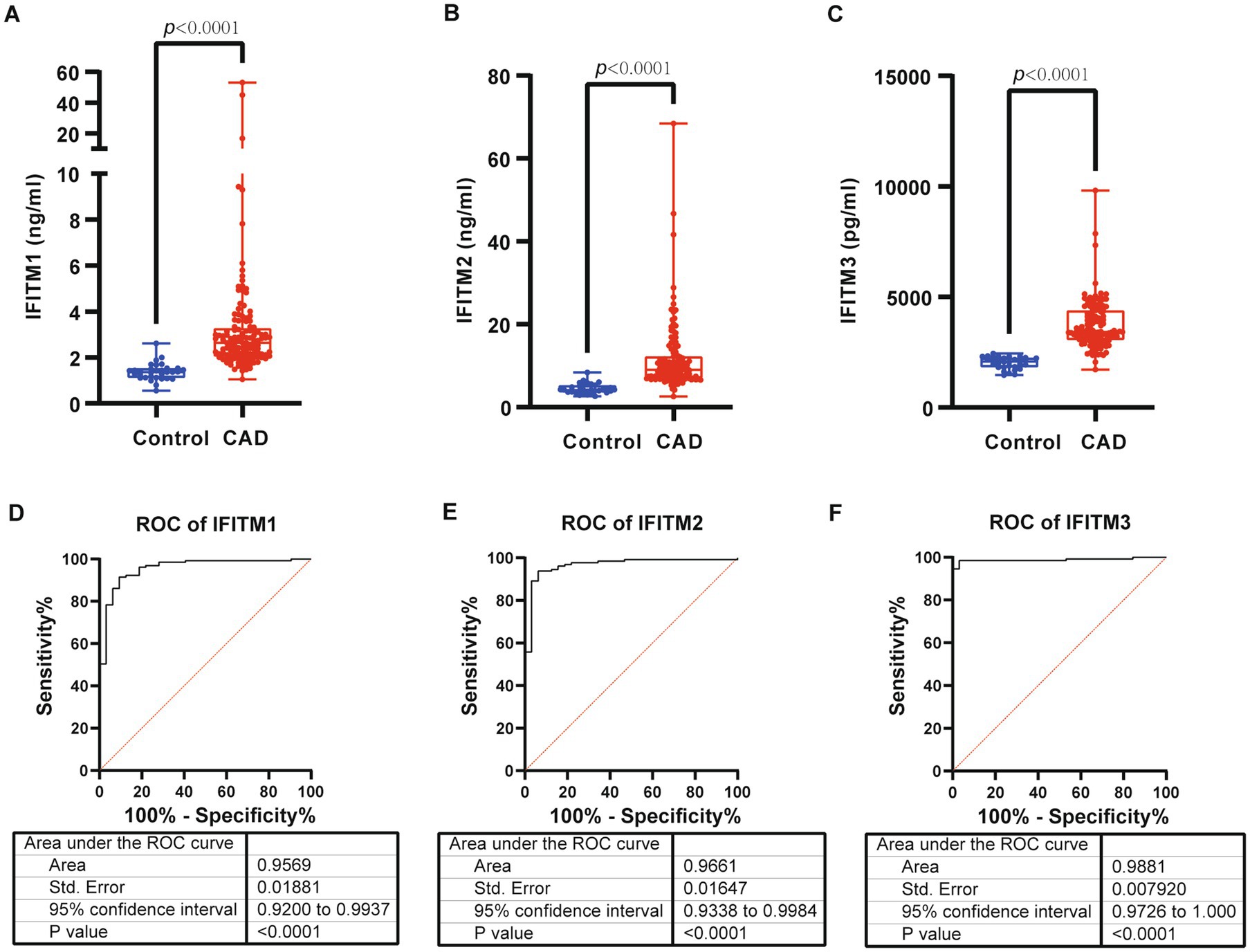
Figure 2. Serum levels and diagnostic performance of IFITM1/2/3 in control and CAD group of discovery cohort. (A–C) Serum IFITM1/2/3 in control and CAD subjects; (D–F) ROC curves of IFITM1/2/3 for determination of CAD. Statistical significance was assessed using Wilcoxon rank-sum test.
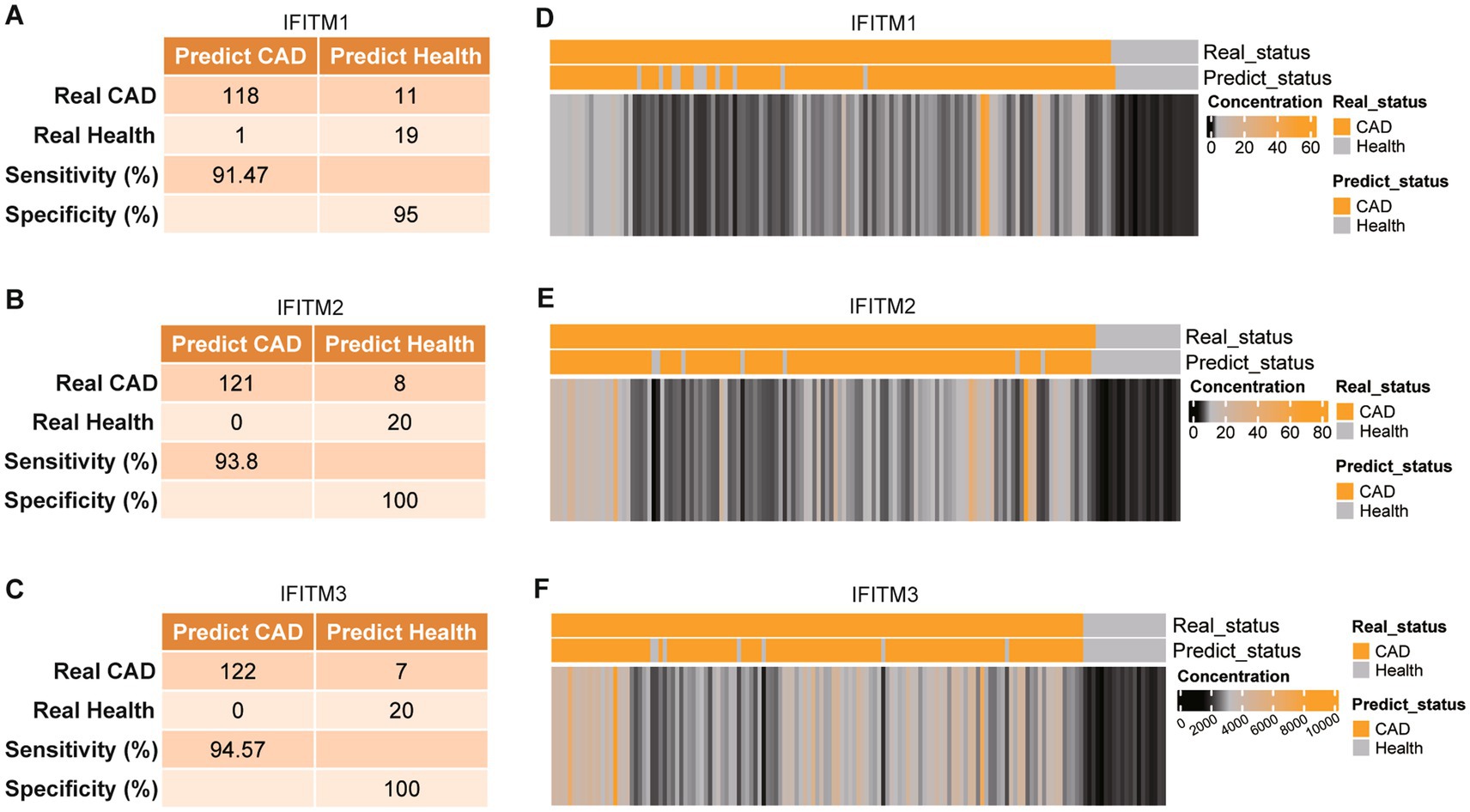
Figure 3. Diagnostic ability of IFITM1/2/3 in discovery cohort. (A–C) Confusion tables of the binary results of IFITM1/2/3; (D–F) Supervised hierarchical clustering of IFITM1/2/3 between health control and CAD.
3.3 Diagnostic discrimination of CAD patients by IFITM1/2/3 from healthy controls
For validation of IFITM proteins’ diagnostic potential, a validation cohort (16 healthy controls, 40 CAD patients) was prospectively analyzed. Consistent with the discovery cohort results, serum levels of IFITM1/2/3 were significantly higher in CAD patients compared with controls (Supplementary Figure S1A–C). ROC analysis confirmed strong diagnostic discrimination, with IFITM1 showing an AUC of 0.9375 (95% CI: 0.8632–1.000; sensitivity 95%, specificity 81.25%), IFITM2 an AUC of 0.8984 (95% CI: 0.8044–1.000; sensitivity 90%, specificity 75%), and IFITM3 a perfect AUC of 1.000 (95% CI: 1.000–1.000; sensitivity 97.5%, specificity 100%) (Supplementary Figures S1D–F, S2A–C). Furthermore, when applying the thresholds from discovery cohort to the validation cohort, all three proteins retained robust classification performance in distinguishing CAD status (Supplementary Figure S2D–F).
3.4 Association of IFITM1/2/3 levels with coronary stenosis severity
For further investigation of IFITM protein levels and CAD severity association, 129 discovery cohort CAD patients were stratified by median Gensini score into low/high-stenosis severity groups. Figures 4G–H display representative coronary angiography images depicting varying stenosis degrees in the two subgroups. Clinical characteristics of the two groups were shown in Table 2. Serum IFITM concentrations showed a gradual increase from the Gensini-low to Gensini-high group (Figures 4A–C). These results suggest a positive correlation between IFITM protein levels and coronary artery stenosis severity. This gradient pattern showed a significant correlation with angiographic severity scores (Figures 5A–C). Furthermore, ROC curve analysis showed that IFITMs exhibited strong discriminatory ability in distinguishing low vs. high stenosis severity, with an AUC of 0.8 (Figures 4D–H).
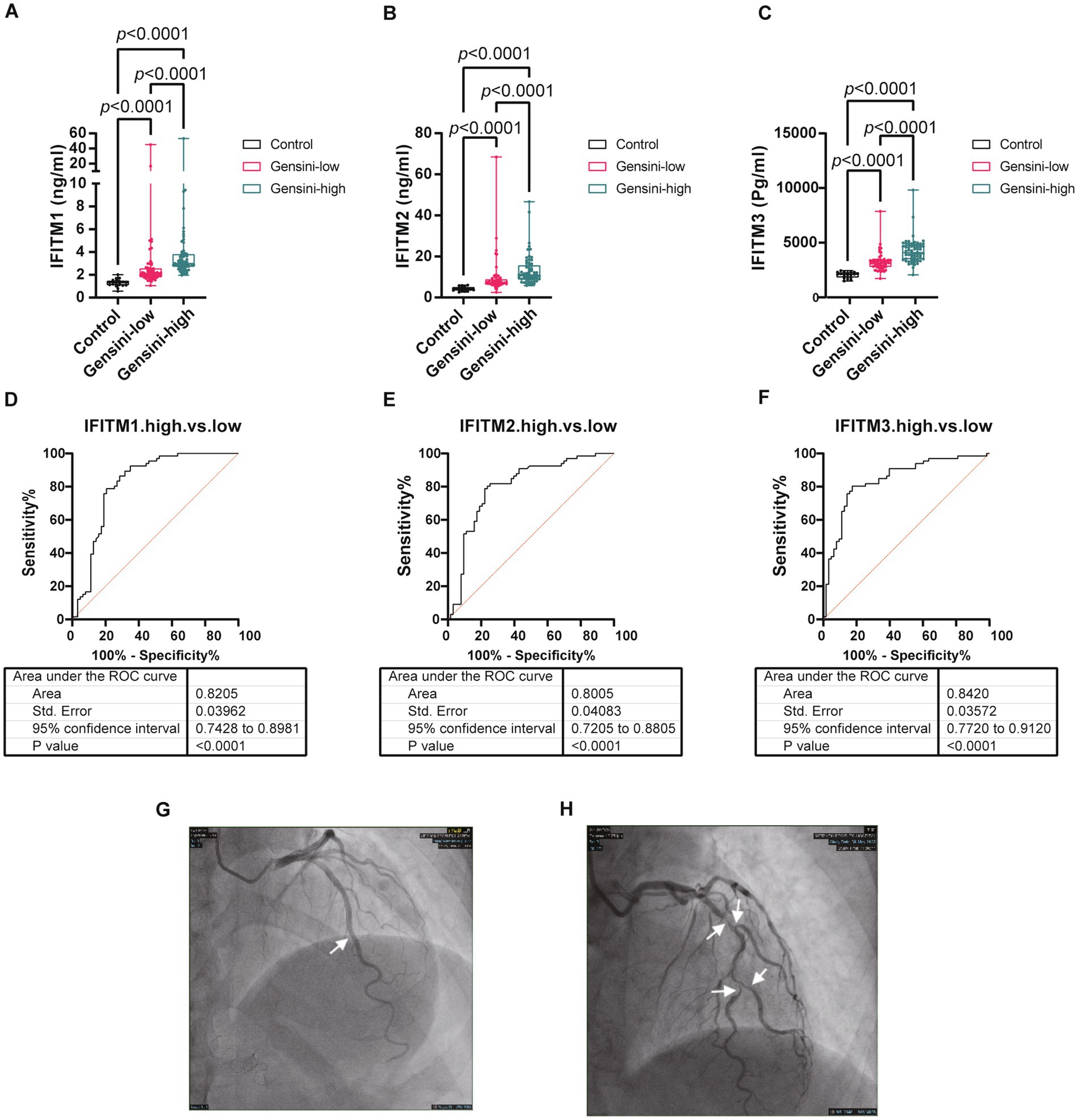
Figure 4. Levels of serum IFITM1/2/3 among different coronary severity groups of discovery cohort. (A–C) Compared IFITM1/2/3 levels in control, Gensini-low and Gensini-high groups; (D–F) ROC curves of IFITM1/2/3 for determination of different coronary severity CAD patients; (G–H) Representative coronary angiography images. Statistical significance was assessed using Kruskal–Wallis H test.

Figure 5. Correlation of serum IFITM1/2/3 with Gensini score. (A–C) The correlation results of IFITMs between Gensini score.
3.5 Comparison of serum IFITM1/2/3 levels in CAD and AMI groups
Subsequent analyses compared serum IFITM1/2/3 concentrations among CAD, AMI and control groups. Baseline clinical characteristics were detailed in Table 3. Comparative analysis showed significantly higher IFITM1/2/3 levels in AMI patients compared with CAD and control groups (Figures 6A–C). ROC curves indicated high diagnostic value of serum IFITM1/2/3 for distinguishing AMI from controls, with AUC values of 0.9934, 0.9928 and 0.9886, respectively (Figures 6D–F). Further stratification of AMI patients into heart failure (AMI-HF) and non-heart failure (AMI-nonHF) subgroups (clinical characteristics detailed in Supplementary Table S1) revealed distinct expression patterns. Notably, IFITM1 levels were significantly higher in AMI-HF patients (2.41 ± 0.38 ng/mL vs. 1.79 ± 0.29 ng/mL, p = 0.007), while IFITM2 and IFITM3 showed no significant expression differences between subgroups (Figures 7A–C). This differential expression profile suggests a potential pathophysiological role for IFITM1 in post-infarction ventricular remodeling and heart failure development, whereas IFITM2/3 appear more broadly associated with acute coronary syndrome pathogenesis. These findings underscore the proteins’ superior discriminatory capacity in acute coronary syndromes and suggest a distinct role for IFITM1 in heart failure progression after acute myocardial infarction.
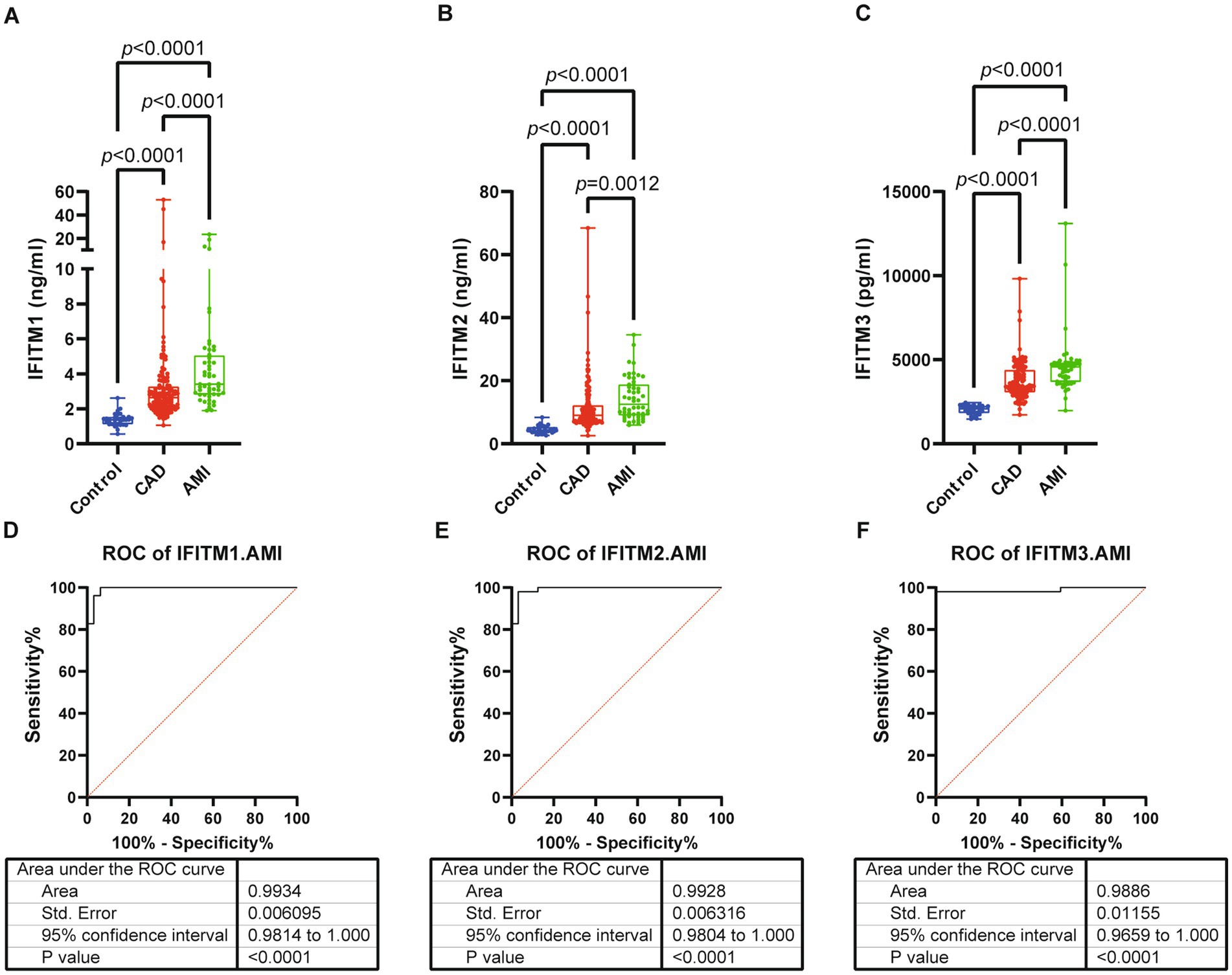
Figure 6. Serum levels and diagnostic performance of IFITM1/2/3 in control, CAD and AMI subjects. (A–C) Serum IFITM1/2/3 among three groups; (D–F) ROC curves of IFITM1/2/3 for determination of AMI from controls. Statistical significance was assessed using using Kruskal–Wallis H test.
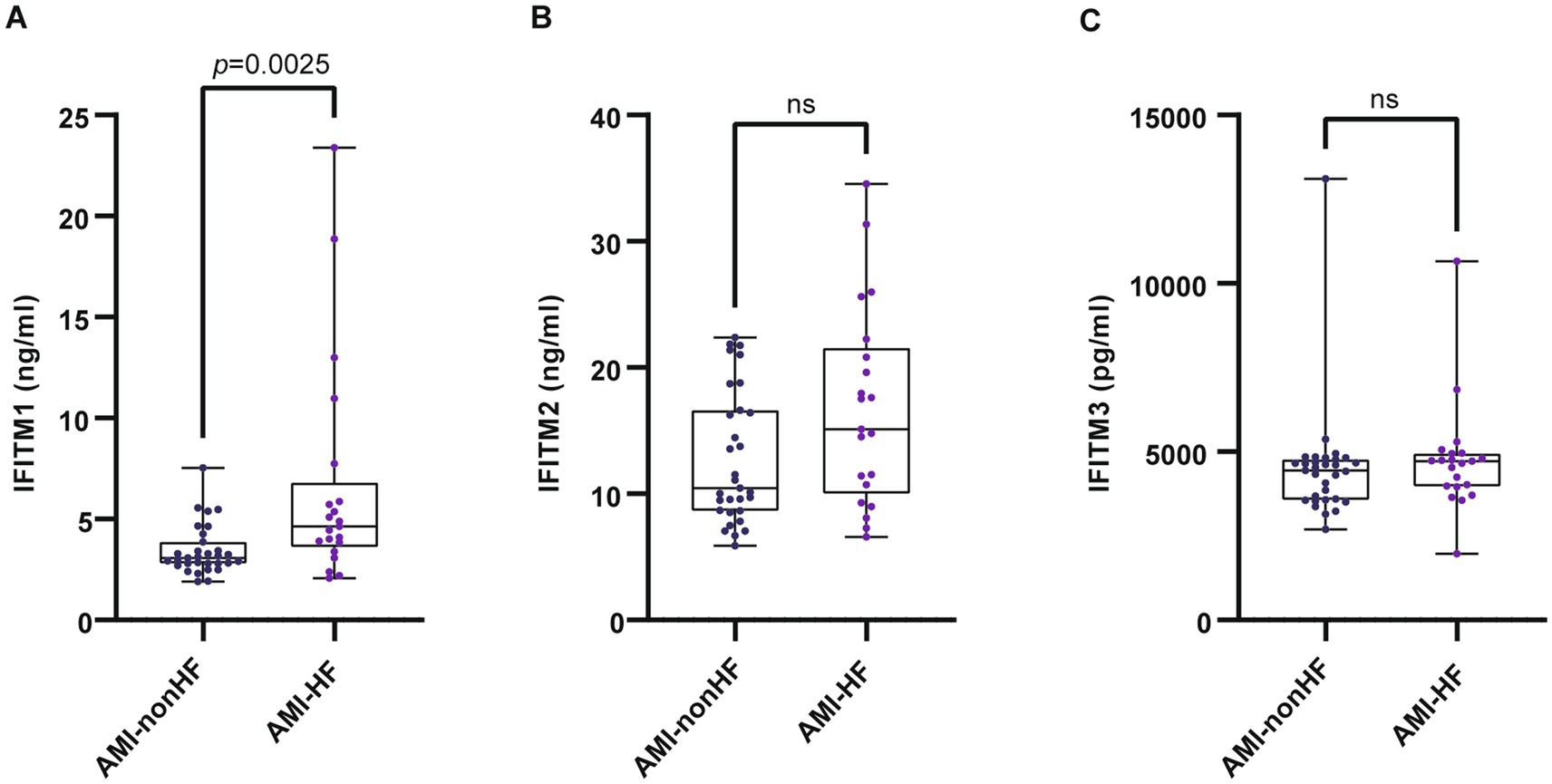
Figure 7. Serum levels of IFITM1/2/3 in AMI-nonHF and AMI-HF groups. (A–C) Compared IFITMs in AMI-nonHF and AMI-HF groups. Statistical significance was assessed using Wilcoxon rank-sum test.
4 Discussion
Coronary artery disease persists as a global health challenge with pressing demands for innovative biomarkers to refine diagnostic precision and therapeutic monitoring. Our study showed that serum IFITM1/2/3 levels were significantly elevated in both stable CAD and AMI patient cohorts and positively correlated with stenosis severity. ROC analysis indicated strong diagnostic performance of all three IFITMs in distinguishing CAD or AMI from controls, with IFITM3 showing superior discriminative ability for CAD. Notably, elevated IFITM1 levels in post-AMI heart failure patients suggested its potential role in post-AMI cardiac decompensation mechanisms.
IFITM1, IFITM2, and IFITM3, the most structurally conserved members of the interferon-induced transmembrane (IFITM) family, have been extensively studied in antiviral defense and oncology (13, 25, 26). IFITM protein levels correlated with coronary stenosis severity (Gensini score) indicated their potential role in CAD pathophysiology. The progressive increase in IFITM levels with increasing stenosis severity suggested that these proteins may be involved in the pathological processes underlying atherosclerosis, such as endothelial dysfunction, inflammation, and thrombosis. Interferon (IFN)-dependent and IFN-independent mechanisms control the expression of IFITM genes in inflammatory conditions. In canonical IFN signaling, the JAK/STAT pathway is activated. This process induces IFITM genes and other interferon-stimulated genes (ISGs) (27). Modulation of IFITM expression extends beyond IFN-mediated mechanisms to include other cytokines (e.g., IL-6, TNF-α, angiotensin II) and molecules like LPS (28–30). This dual regulatory architecture enables context-specific IFITM induction across diverse inflammatory environments, potentially linking their functions to broader pathophysiological processes such as vascular inflammation or cytokine storm responses. A recent integrative multi-omics study further underscores the importance of STAT1-driven transcriptional programs in macrophages within atherosclerotic plaques, which aligns with the potential upstream regulation of IFITMs in cardiovascular inflammation (31). Building on the association with CAD and atherosclerosis, our group investigated a specific functional role. We demonstrated that IFITM1 contributes directly to atherosclerosis by regulating the phenotypic switch of vascular smooth muscle cells (VSMCs). Mechanistically, IFITM1 promotes VSMC proliferation, migration, and macrophage-like transdifferentiation through activation of the c-Src/MAPK/GATA2/E2F2 signaling pathway, thereby driving atherosclerotic plaque development (23).
In addition to their diagnostic potential, our findings also suggest a role for IFITM proteins in the pathogenesis of AMI. Significantly higher IFITM1/2/3 levels in AMI patients compared with CAD and control groups suggest their involvement in acute myocardial infarction responses. AMI, from coronary artery obstruction, causes myocardial ischemia-hypoxia, cardiac dysfunction, and detrimental effects: myocardial damage, heart failure, ventricular remodeling, reduced systolic function (32). Cellular death is a hallmark of AMI pathology. Damaged cells release their intracellular contents, including damage-associated molecular patterns (DAMPs), into the extracellular space. The immune system detects these DAMPs, initiating an inflammatory response (33, 34). Sustained and dysregulated inflammatory responses may exacerbate myocardial tissue damage and drive maladaptive cardiac remodeling. Thus, elevated inflammation in AMI may explain the higher IFITM levels in AMI patients compared with CAD patients. This notion is supported by a single-cell transcriptomic study in a murine MI model, which identified a distinct subpopulation of cardiac-infiltrating neutrophils characterized by high expression of Ifitm1, suggesting a specific role for IFITM1 in the local immune response following ischemic injury (35).
Another notable finding is that IFITM1 is selectively upregulated in post-AMI heart failure and negatively correlated with Ejection Fraction (EF) or Fractional Shortening (FS) (Supplementary Figure S3), which warrants attention. Preliminary studies suggested that IFITM may play a role in modulating cardiac function. Bin et al. (36) showed that IFITM1, a key immune-related gene in dilated cardiomyopathy (DCM), was significantly upregulated in T-cell-related subpathways, suggesting its potential role in disease progression via T-cell-mediated immune dysfunction. Furthermore, Xu et al.’s study (22) identified IFITM1, IFITM2, and IFITM3 as immune-related differentially expressed genes in DCM, implying that their aberrant expression may contribute to myocardial dysfunction through dysregulated immune-inflammatory pathways. Additionally, Xiong et al. (37) elucidated the specific mechanism of action of IFITM3, confirming that it exacerbates myocardial injury associated with myocarditis by activating the JAK2/STAT3 signaling pathway. Based on current evidence, we speculate that IFITMs may regulate myocardial function through immune-inflammatory signaling pathways, thereby contributing to post-infarction heart failure.
Collectively, our findings indicate that IFITM proteins could serve as novel, efficient, and promising diagnostic biomarkers for CAD and AMI. Unlike conventional imaging (invasive or radiation-based), IFITM testing offers non-invasive blood-based diagnosis with superior accuracy and operational efficiency. Compared with established serum biomarkers like C-reactive protein (CRP) and lipid markers, IFITM proteins show unique utility in stratifying disease severity in CAD.
Our study has several limitations. First, its single-center design and the recruitment of patients from a tertiary hospital introduce a substantial risk of referral bias. Our cohort likely represents a population with more severe or complex disease, which may limit the generalizability of our findings to community-based or primary care settings with milder cases. Second, the retrospective design, while suitable for this initial exploratory study, inherently restricts causal inference between IFITM levels and CAD/AMI. Third, despite our efforts to control for key clinical variables through multivariable analysis, the possibility of residual or unmeasured confounding persists. Factors such as detailed medication history (e.g., statins), lifestyle factors, and other unassessed inflammatory markers could potentially influence both IFITM expression and disease status. Fourth, as an initial study, the sample size was determined by data availability. Although a post-hoc analysis indicated high statistical power for our primary findings, the sample size, particularly of the validation cohort, remains modest. Future large-scale, multicenter prospective studies are warranted to confirm the diagnostic and prognostic value of IFITM proteins in a more generalizable population and to allow for more comprehensive adjustment of confounders.
5 Conclusion
Our study identifies serum IFITM1, IFITM2, and IFITM3 as novel and promising biomarkers for the diagnosis of CAD and AMI. The specific upregulation of IFITM1 in post-AMI heart failure suggests a potential distinct role in maladaptive remodeling. While these findings are compelling, they originate from a single-center cohort with inherent limitations such as potential referral bias. Therefore, future research should prioritize large-scale, prospective multicenter studies to validate the clinical utility of IFITMs, and further mechanistic investigations are warranted to elucidate their precise pathophysiological roles in atherosclerosis and post-infarction complications.
Data availability statement
The raw data supporting the conclusions of this article will be made available by the authors, without undue reservation.
Ethics statement
The studies involving humans were approved by Ethics Committee of Meizhou People’s Hospital. The studies were conducted in accordance with the local legislation and institutional requirements. The human samples used in this study were acquired from our biobank. All protocols involving human samples were approved by the Ethical Committee of Meizhou People’s Hospital (Approval no. 2023-C) and informed consent was obtained from all subjects or their relatives prior to participation. Written informed consent for participation was not required from the participants or the participants’ legal guardians/next of kin in accordance with the national legislation and institutional requirements.
Author contributions
QinH: Writing – original draft. XZ: Writing – original draft. YG: Writing – original draft. SZ: Writing – original draft. JZ: Writing – original draft. XT: Writing – review & editing. MH: Writing – review & editing. QioH: Writing – review & editing.
Funding
The author(s) declare that financial support was received for the research and/or publication of this article. This study was supported by the Medical Scientific Research Foundation of Guangdong Province (A2025202), Scientific Research and Cultivation Project of Meizhou People’s Hospital (PY-C2025013), and High-Level Talent Scientific Research Startup Fund Project of Meizhou People’s Hospital (KYQD202305; KYQD202306).
Conflict of interest
The authors declare that the research was conducted in the absence of any commercial or financial relationships that could be construed as a potential conflict of interest.
Generative AI statement
The authors declare that no Gen AI was used in the creation of this manuscript.
Any alternative text (alt text) provided alongside figures in this article has been generated by Frontiers with the support of artificial intelligence and reasonable efforts have been made to ensure accuracy, including review by the authors wherever possible. If you identify any issues, please contact us.
Publisher’s note
All claims expressed in this article are solely those of the authors and do not necessarily represent those of their affiliated organizations, or those of the publisher, the editors and the reviewers. Any product that may be evaluated in this article, or claim that may be made by its manufacturer, is not guaranteed or endorsed by the publisher.
Supplementary material
The Supplementary material for this article can be found online at: https://www.frontiersin.org/articles/10.3389/fmed.2025.1645725/full#supplementary-material
References
1. Vaduganathan, M, Mensah, GA, Turco, JV, Fuster, V, and Roth, GA. The global burden of cardiovascular diseases and risk. J Am Coll Cardiol. (2022) 80:2361–71. doi: 10.1016/j.jacc.2022.11.005
2. Libby, P, and Theroux, P. Pathophysiology of coronary artery disease. Circulation. (2005) 111:3481–8. doi: 10.1161/circulationaha.105.537878
3. Medina-Leyte, DJ, Zepeda-García, O, Domínguez-Pérez, M, González-Garrido, A, Villarreal-Molina, T, and Jacobo-Albavera, L. Endothelial dysfunction, inflammation and coronary artery disease: potential biomarkers and promising Therapeutical approaches. Int J Mol Sci. (2021) 22:3850. doi: 10.3390/ijms22083850
4. Fox, KAA, Metra, M, Morais, J, and Atar, D. The myth of ‘stable’ coronary artery disease. Nat Rev Cardiol. (2019) 17:9–21. doi: 10.1038/s41569-019-0233-y
5. Agrawal, H, Choy, H-HK, Liu, J, Auyoung, M, and Albert, MA. Coronary artery disease. Arterioscler Thromb Vasc Biol. (2020) 40:e185–92. doi: 10.1161/ATVBAHA.120.313608
6. Ardahanlı, İ, Aslan, R, Özkan, Hİ, Özel, F, and Özmen, M. A contemporary review of thoracic aortic aneurysm: from molecular pathogenesis to clinical integration. J Vascular Dis. (2025) 4:26. doi: 10.3390/jvd4030026
7. Morinaga, J, Kashiwabara, K, Torigoe, D, Okadome, Y, Aizawa, K, Uemura, K, et al. Plasma ANGPTL8 levels and risk for secondary cardiovascular events in Japanese patients with stable coronary artery disease receiving statin therapy. Arterioscler Thromb Vasc Biol. (2023) 43:1549–59. doi: 10.1161/ATVBAHA.122.318880
8. Gilliland, TC, Liu, Y, Mohebi, R, Miksenas, H, Haidermota, S, Wong, M, et al. Lipoprotein(a), oxidized phospholipids, and coronary artery disease severity and outcomes. J Am Coll Cardiol. (2023) 81:1780–92. doi: 10.1016/j.jacc.2023.02.050
9. Kaplangoray, M, Toprak, K, Aslan, R, Deveci, E, Gunes, A, and Ardahanli, İ. High CRP-albumin ratio is associated high thrombus burden in patients with newly diagnosed STEMI. Medicine. (2023) 102:e35363. doi: 10.1097/MD.0000000000035363
10. Karagiannidis, E, Moysidis, DV, Papazoglou, AS, Panteris, E, Deda, O, Stalikas, N, et al. Prognostic significance of metabolomic biomarkers in patients with diabetes mellitus and coronary artery disease. Cardiovasc Diabetol. (2022) 21:70. doi: 10.1186/s12933-022-01494-9
11. Friedlová, N, Zavadil Kokáš, F, Hupp, TR, Vojtěšek, B, and Nekulová, M. IFITM protein regulation and functions: far beyond the fight against viruses. Front Immunol. (2022) 13:1042368. doi: 10.3389/fimmu.2022.1042368
12. Robinson-Rechavi, M, Zhang, Z, Liu, J, Li, M, Yang, H, and Zhang, C. Evolutionary dynamics of the interferon-induced transmembrane gene family in vertebrates. PLoS One. (2012) 7:e49265. doi: 10.1371/journal.pone.0049265
13. Gómez-Herranz, M, Taylor, J, and Sloan, RD. IFITM proteins: understanding their diverse roles in viral infection, cancer, and immunity. J Biol Chem. (2023) 299:102741. doi: 10.1016/j.jbc.2022.102741
14. Kim, BS, Yang, SS, Kim, CS, and Lee, J. Zoledronate suppresses VEGFinduced capillary tube formation and inhibits expression of interferoninduced transmembrane protein1 in human umbilical vein endothelial cells. Int J Mol Med. (2018) 41:2879–84. doi: 10.3892/ijmm.2018.3497
15. He, JD, Luo, HL, Li, J, Feng, WT, and Chen, LB. Influences of the interferon induced transmembrane protein 1 on the proliferation, invasion, and metastasis of the colorectal cancer SW480 cell lines. Chin Med J. (2012) 125:517–22. doi: 10.3760/cma.j.issn.0366-6999.2012.03.021
16. Yan, J, Jiang, Y, Lu, J, Wu, J, and Zhang, M. Inhibiting of proliferation, migration, and invasion in lung Cancer induced by silencing interferon-induced transmembrane protein 1 (IFITM1). Biomed Res Int. (2019) 2019:1–9. doi: 10.1155/2019/9085435
17. Ashley, CL, Abendroth, A, McSharry, BP, and Slobedman, B. Interferon-independent innate responses to cytomegalovirus. Front Immunol. (2019) 10:2751. doi: 10.3389/fimmu.2019.02751
18. Bezman, NA, Kim, CC, Sun, JC, Min-Oo, G, Hendricks, DW, Kamimura, Y, et al. Molecular definition of the identity and activation of natural killer cells. Nat Immunol. (2012) 13:1000–9. doi: 10.1038/ni.2395
19. Yánez, DC, Ross, S, and Crompton, T. The IFITM protein family in adaptive immunity. Immunology. (2019) 159:365–72. doi: 10.1111/imm.13163
20. Lau, SLY, Yuen, ML, Kou, CYC, Au, KW, Zhou, J, and Tsui, SKW. Interferons induce the expression of IFITM1 and IFITM3 and suppress the proliferation of rat neonatal cardiomyocytes. J Cell Biochem. (2012) 113:841–7. doi: 10.1002/jcb.23412
21. Bhat, KG, Guleria, VS, J, RK, Rastogi, G, Sharma, V, and Sharma, A. Preliminary genome wide screening identifies new variants associated with coronary artery disease in Indian population. Am J Transl Res. (2022) 14:5124–31.
22. Xu, S, Wu, Z, and Chen, H. Construction and evaluation of immune-related diagnostic model in patients with heart failure caused by idiopathic dilated cardiomyopathy. BMC Cardiovasc Disord. (2024) 24:92. doi: 10.1186/s12872-023-03666-1
23. Huang, Q-H, Tang, X-Y, Huang, Q-Y, Zhi, S-B, Zheng, X-Q, Gan, C-Y, et al. IFITM1 promotes proliferation, migration and macrophage-like transdifferentiation of vascular smooth muscle cells via c-Src/MAPK/GATA2/E2F2 pathway in atherosclerosis. Biochem Pharmacol. (2025) 239:117014. doi: 10.1016/j.bcp.2025.117014
24. Rampidis, GP, Benetos, G, Benz, DC, Giannopoulos, AA, and Buechel, RR. A guide for Gensini Score calculation. Atherosclerosis. (2019) 287:181–3. doi: 10.1016/j.atherosclerosis.2019.05.012
25. Cheon, H, Borden, EC, and Stark, GR. Interferons and their stimulated genes in the tumor microenvironment. Semin Oncol. (2014) 41:156–73. doi: 10.1053/j.seminoncol.2014.02.002
26. Zhao, X, Li, J, Winkler, CA, An, P, and Guo, J-T. IFITM genes, variants, and their roles in the control and pathogenesis of viral infections. Front Microbiol. (2019) 9:3228. doi: 10.3389/fmicb.2018.03228
27. Schneider, WM, Chevillotte, MD, and Rice, CM. Interferon-stimulated genes: a complex web of host defenses. Annu Rev Immunol. (2014) 32:513–45. doi: 10.1146/annurev-immunol-032713-120231
28. Bailey, CC, Huang, IC, Kam, C, and Farzan, M. Ifitm3 limits the severity of acute influenza in mice. PLoS Pathog. (2012) 8:e1002909. doi: 10.1371/journal.ppat.1002909
29. Daido, H, Zhou, MY, and Gomez-Sanchez, CE. Angiotensin stimulates the expression of interferon-inducible genes in H295R cells. Mol Cell Endocrinol. (2001) 176:21–7. doi: 10.1016/S0303-7207(01)00478-6
30. Harmon, E, Doan, A, Bautista-Garrido, J, Jung, JE, Marrelli, SP, and Kim, GS. Increased expression of interferon-induced transmembrane 3 (IFITM3) in stroke and other inflammatory conditions in the brain. Int J Mol Sci. (2022) 23:8885. doi: 10.3390/ijms23168885
31. Eskandarian Boroujeni, M, Lopacinska, N, Antonczyk, A, Kluzek, K, Wesoly, J, and Bluyssen, HAR. Integrative multi-omics analysis of IFNγ-induced macrophages and atherosclerotic plaques reveals macrophage-dependent STAT1-driven transcription in atherosclerosis. Front Immunol. (2025) 16:1590953. doi: 10.3389/fimmu.2025.1590953
32. Zhu, L, Liu, Y, Wang, K, and Wang, N. Regulated cell death in acute myocardial infarction: molecular mechanisms and therapeutic implications. Ageing Res Rev. (2025) 104:102629. doi: 10.1016/j.arr.2024.102629
33. Galluzzi, L, Vitale, I, Aaronson, SA, Abrams, JM, Adam, D, Agostinis, P, et al. Molecular mechanisms of cell death: recommendations of the nomenclature committee on cell death 2018. Cell Death Differ. (2018) 25:486–541. doi: 10.1038/s41418-017-0012-4
34. Ong, S-B, Hernández-Reséndiz, S, Crespo-Avilan, GE, Mukhametshina, RT, Kwek, X-Y, Cabrera-Fuentes, HA, et al. Inflammation following acute myocardial infarction: multiple players, dynamic roles, and novel therapeutic opportunities. Pharmacol Ther. (2018) 186:73–87. doi: 10.1016/j.pharmthera.2018.01.001
35. Vafadarnejad, E, Rizzo, G, Krampert, L, Arampatzi, P, Arias-Loza, A-P, Nazzal, Y, et al. Dynamics of cardiac neutrophil diversity in murine myocardial infarction. Circ Res. (2020) 127:e232–49. doi: 10.1161/CIRCRESAHA.120.317200
36. Qi, B, Wang, H-Y, Ma, X, Chi, Y-F, and Gui, C. Identification of the key genes of immune infiltration in dilated cardiomyopathy. Int Heart J. (2023) 64:1054–64. doi: 10.1536/ihj.23-182
Keywords: biomarkers, coronary artery disease, acute myocardial infarction, IFITM1, IFITM2, IFITM3
Citation: Huang Q, Zheng X, Gan Y, Zhi S, Zhu J, Tang X, Huang M and Huang Q (2025) Interferon-induced transmembrane proteins as biomarkers for assessing the diagnosis and severity of coronary artery disease and acute myocardial infarction. Front. Med. 12:1645725. doi: 10.3389/fmed.2025.1645725
Edited by:
Kayode O. Kuku, University Medical Center Groningen, NetherlandsReviewed by:
Rehab H. Werida, Damanhour University, Egyptİsa Ardahanlı, Bilecik Şeyh Edebali University, Türkiye
Smita Verma, Emory University, United States
Copyright © 2025 Huang, Zheng, Gan, Zhi, Zhu, Tang, Huang and Huang. This is an open-access article distributed under the terms of the Creative Commons Attribution License (CC BY). The use, distribution or reproduction in other forums is permitted, provided the original author(s) and the copyright owner(s) are credited and that the original publication in this journal is cited, in accordance with accepted academic practice. No use, distribution or reproduction is permitted which does not comply with these terms.
*Correspondence: Mingfeng Huang, aHVhbmdtaW5nZmVuZ0BtenJteXkuY29t; Qionghui Huang, aHVhbmdxaW9uZ2h1aUBtenJteXkuY29t
†These authors have contributed equally to this work
 Qingyan Huang
Qingyan Huang Xiaoqi Zheng1,2†
Xiaoqi Zheng1,2† Mingfeng Huang
Mingfeng Huang